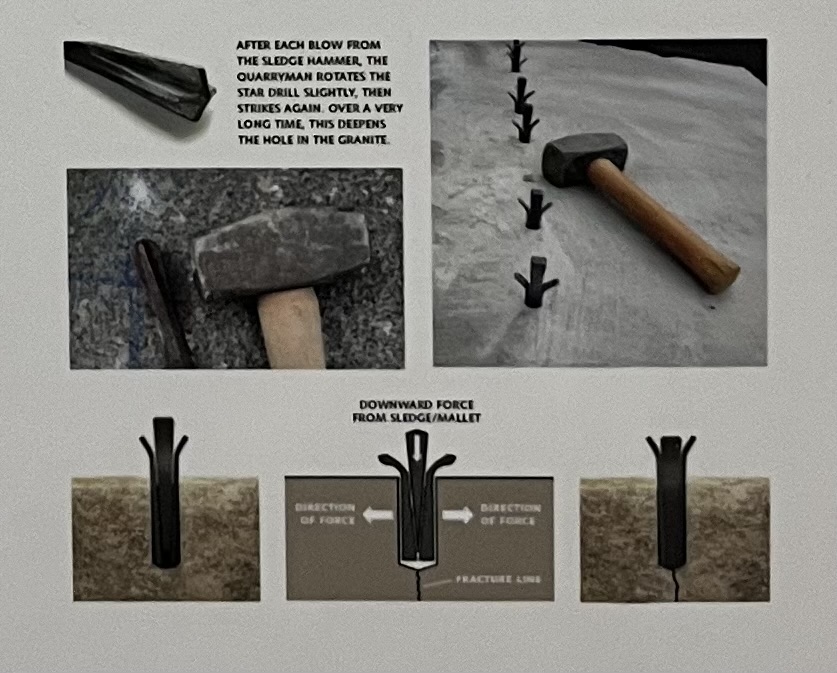
"Postern Gate No. 4 – A Wish for Spring" by Ernest Oliver Brown
As you round the stairway to the lower level of the library, upon passing the J.F. Kensett photomural, you will see this artwork, which was gifted to the library by the artist, Ernest Oliver Brown. To the left of the artwork, there is a plaque that describes the piece both from the artist’s point of view and from a historical standpoint, as follows:
“A note from the artist: “Postern gate” is an architectural term for a small/secret gate in a castle wall for a person to reach the outside of the castle without going through the formal front gate . . . to fish (or to throw garbage in the moat), to slip away unnoticed, or other activity. This phrase I had used to tide this actual configuration of granite stone posts.
This configuration exists in front of “Hale House” on the West Side Road in North Conway, NH. A very old house dating from the mid-1700s. The postern gate would allow a person to reach the house across the open “lawn”, but would not let your horse or wandering cattle to follow . . . as the space between the stone posts was only wide enough to accommodate a human. It would also keep the grazing sheep — used to keep the grass in front of the house “trim” — from wandering off site.
This is my fourth painting of this scene and hopefully the last and the best . . . that’s why my self-portrait has me walking away to other things.
Time to paint Spring somewhere else!
Time of Scene: late February–early March . . . mid-afternoon looking North East . . . it will freeze again tonight . . . the standing water will ice over again . . . the green Spring grass is still hidden under the mats of long field grass pressed down by the weight of this Winter’s snow . . . weak, partly cloudy, sunlight, thru bare trees and one lone pine tree, light the beginnings of Spring here . . . but icy snow still hugs the shades of the nearby treelines till May . . . there is no longer a trim “lawn” to welcome passing horse-riding visitors . . . and old rusty fence wire keeps in or out nothing of much contemporary concern.
Compositionally this painting is divided into fifths, not thirds, to offset the square, stable, nearly mundane, 4 x 4 space. Yet the square panel is as stable as the granite posts of the gate . . . quarried on the property, set by the landowner, and even after a couple hundred years, still standing to welcome visitors and keep the livestock at bay.
And as any good Yankee knows, the posts will not rot away, they rarely move (much) and once placed . . . they are there “ ’till you take ’em out.”
A note about the objects displayed below: Stone posts are a common subject for Mr. Brown, and may be found everywhere in our landscape. They reflect a Yankee resourcefulness of “making something out of nothin’.” The farmer/landowner usually served as quarryman. The evidence for how these posts were made can be seen in the painting.
The five short horizontal lines seen in the post on the left are tool marks left by the drilling and splitting of the stone. The quarryman used a hammer and star-tipped bit to drill a series of holes about three inches deep along the line he wanted to split the stone — a laborious and extremely slow process. When the holes were deep enough, he inserted a pair of “feathers” into each hole, and then hammered a wedge or plug between the feathers.
If all worked out well, the stone split along a relatively straight line. The stones were fashioned into foundation blocks for cellar holes, cemetery fence walls, door stoops, hearth stones, and so on. However, things did not always work out for the quarrymen: Throughout the woods, you can find examples where they started to quarry a boulder, but for some reason they abandoned their work and left the drilled holes filled with the feathers and wedges, which then rusted in place over time. Bob Cottrell”

Image as found on plaque
For more information about this art installment, see Bob Cottrell’s blog post here.
